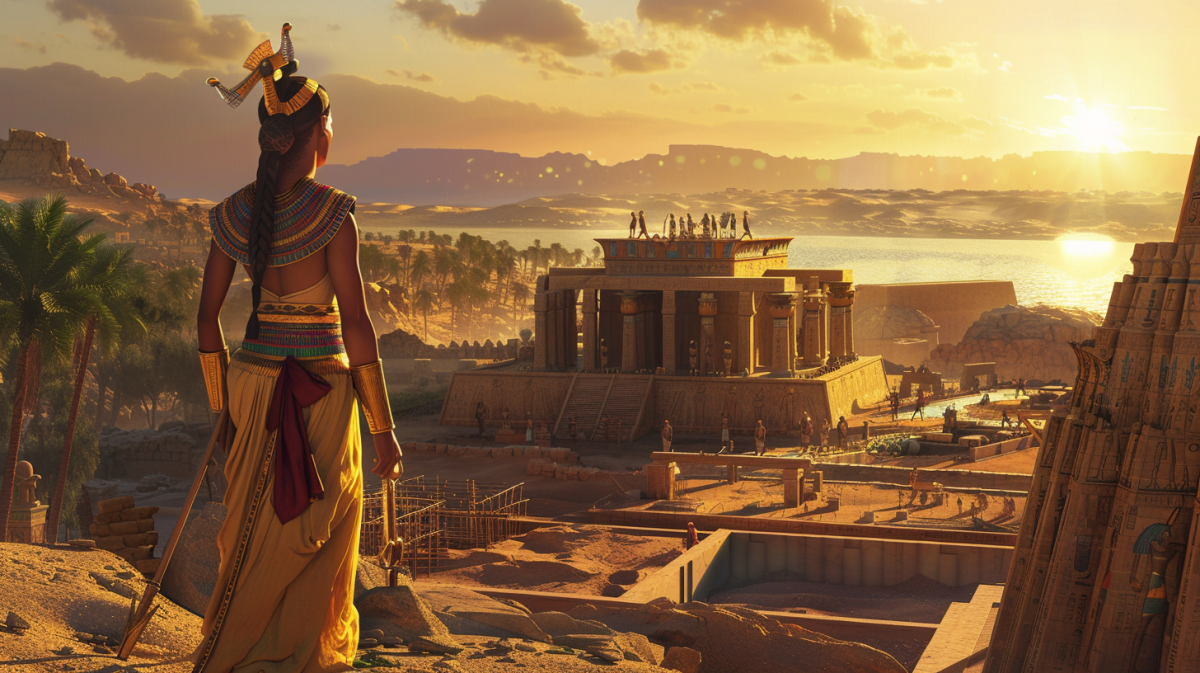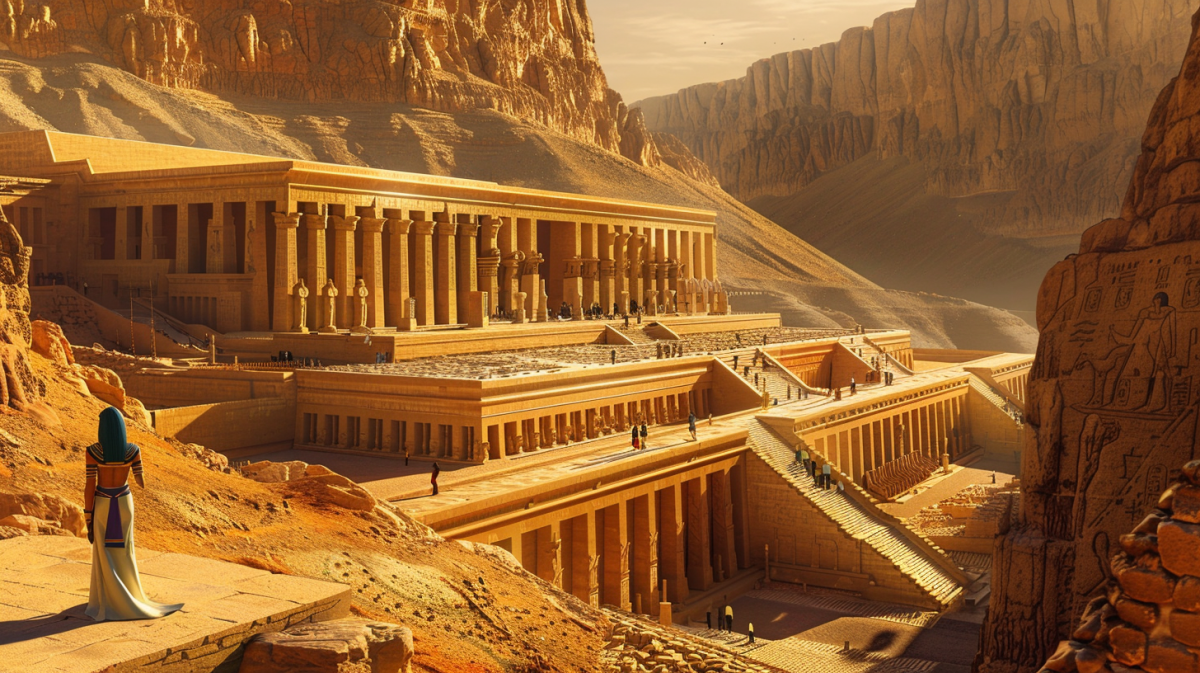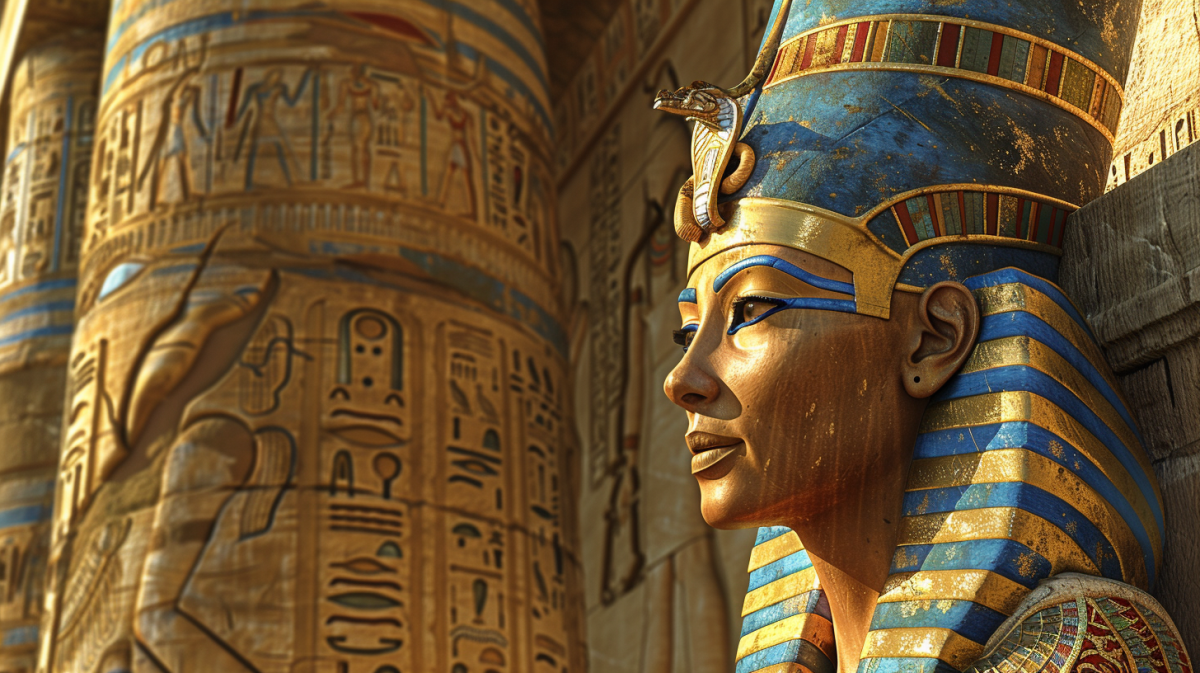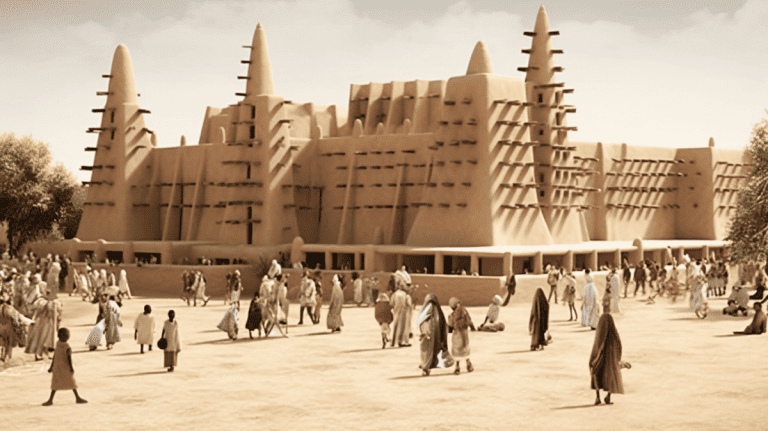The Temple of Hatshepsut, located in Luxor, Egypt, is a stunning architectural feat from the 18th Dynasty. Built for the powerful female Pharaoh Hatshepsut, it’s a unique terraced structure that stands testament to her reign and innovative artistry.

When was the temple of Hatshepsut built?
The temple of Hatshepsut was built around 1478 BC. The Hatshepsut temple is located at Dier el-Bahri. Queen Hatshepsut named the temple Dresser Djeseru, which means “Holy of Holies”.
Inspiration for the temple of Hatshepsut
One of the key duties of an Egyptian monarch was to construct monumental buildings to preserve their memory and the stories of their reign for eternity. Egyptian monarchs also constructed these buildings to honour the gods and this ensured the Egyptian kingdom was a unified state.
The building projects guaranteed work for the farmers and unity was ensured due to the pride of contributing to the project through collective effort. These projects led to the expression of ma’at (harmony/balance) thanks to the national and communal effort needed for these projects which was the central value of the ancient Egyptian culture.
When Queen Hatshepsut became Pharaoh in 1478 BC, she commissioned numerous building projects across Egypt. Temples, obelisks and pylons were being built at such a high rate and more craftsmen than ever were working on large projects. The quality of the construction was nothing like the Egyptians had seen in such a long time, with red granite obelisks at the Karnak temple as well as temples being carved out of rock. Before Queen Hatshepsut came into power, Egypt was a country full of buildings made of mud-brick.

Hatshepsut commissioned these building projects, particularly obelisks to show she was ordained by the gods to legitimise her position and strengthen her rule. This is because obelisks were seen as a miracle, something only someone chosen by the gods can achieve and Hatshepsut built plenty.
The mortuary temple of Hatshepsut was the most innovative building project in ancient history. The temple of Hatshepsut took inspiration from the temple of Mentuhotep II, (2061-2010BC). Mentuhotep II founded the 11th Dynasty of Egypt and was the catalyst for the Middle Kingdom of Egypt which lasted from 2040-1782 BC.
Mentuhotep II was referred to as a “second Menes”, Menes was a legendary king because he united upper and lower Egypt, making him the founder of the First Dynasty of Egypt. Mentuhotep II was venerated highly throughout ancient Egypt’s history.
The temple of Mentuhotep II was built at Dier el-Bahri, across the river from Thebes and was the first construction in that area. The development was innovative because it was a temple and a tomb. The temple of Mentuhotep II blended with the landscape and was surrounded by towering cliffs. The temple of Hatshepsut was the most elaborate building in ancient Egypt.

Hatshepsut admired Mentuhotep II’s temple, so she had her temple mirror it but on a grander scale, she commissioned her temple to be built next to Mentuhotep’s temple. This was a great way to increase her public image as well as ensure her name was going to be in the history books for a long time.
The temple of Hatshepsut was a homage to Mentuhotep II, but it also linked Hatshepsut to the great history of Egypt. By surpassing impressive monumental work from the past, Hatshepsut strengthened the authority and legitimacy of her reign.
Design & Layout of the temple of Hatshepsut
The mortuary temple of Hatshepsut was designed to surpass all other temples in scale, elegance and grandeur. The temple of Hatshepsut was also designed to tell the story of her reign and her life. Every aspect of Mentuhotep II’s temple was mired but longer, larger and more elaborate.
The temple of Hatshepsut was considered to be a wonder of the ancient world by architects. Located at the bottom of limestone cliffs, the temple had courtyards and terraced colonnades that seems to be going up the side of the mountain.
The lower levels of the temple had gardens with fragrant trees and pools. The temple had huge images of Hatshepsut with over 100 large statues of Pharaoh Hatshepsut as a sphinx, guarding the processional way.

The temple had large ramps leading to the different levels and each level had colonnades, statues, paintings and elaborate reliefs each telling a part of her story. Despite the huge scale of the temple, around the length of two and a half football fields, the design and layout were light and graceful, not a fortress, unlike the temples of the Pharaohs before her.
The ramp which leads to the third level had the Birth Colonnade on the right. This area told the story of her divine birth with the god Amun as her father. Hatshepsut had the story of her birth inscribed on the walls, describing how the god Amun conceived her with her mother. By claiming she is the daughter of the most popular and powerful god of Egypt at the time, Hatshepsut gave herself the privilege to rule Egypt, despite being a woman. By securing her unique relationship with Amun, she removed any criticism of her reign.
On the left of the ramp that leads to the third level, there is the Punt Colonnade with a series of reliefs showing her expedition to Punt. The reliefs showed boats being loaded with highly valuable luxury goods such as incense trees, exotic animals, ebony, ivory and gold. One of the inscriptions reads “Never, were such things brought to any king since the world was”.
Uses for the temple of Hatshepsut
When the temple was built, it was used to showcase all of the achievements of Hatshepsut. This temple was also built to be her funerary temple. On the second level of the temple, Hatshepsut had a temple for Anubis, who is the guardian and guide to death. This was the best practice for any mortuary temple as Anubis was the god who was responsible for leading souls from the tomb to the afterlife.
The temple was also a sanctuary for the god Amun-Ra. The ramp to the third level brought the visitor to the sanctuary of Amun-Ra. The most sacred part of the temple was cut from the limestone cliff the temple was built into. Located in the centre of the ramp leading to the third level, there were three structures; The Royal Cult Chapel, The Solar Cult Chapel and the Sanctuary of Amun-Ra. The Royal Cult and the Solar Cult Chapel had images of the royal family making offerings to the gods. Amun-Ra was a prominent feature in the Solar Chapel since Amun-Ra was the sun, god and creator. There were images of Hatshepsut and her direct family kneeling in front of Amun-Ra in honour.
By the 7th Century AD, the temple of Hatshepsut was used as a Coptic monastery during the early Christian Era. The temple of Hatshepsut is now known as the Temple of Dier El-Bahri which means “Temple of the Northern Monastery” in Arabic.
The temple after Hatshepsut’s Reign
After the reign of Hatshepsut, Thutmose III and other Pharaohs defaced the inner reliefs, inscriptions and paintings in the temple of Hatshepsut. They claimed the temple to be theirs whenever they came to power so each of them had their own plans and agendas of what to do with the temple. Akhenaten, the Pharaoh after Thutmose III defaced the temple due to religious reasons as he did not have any issues with Hatshepsut being a female Pharaoh.
Akhenaten abolished traditional religious beliefs and practices in Egypt and replaced them with monotheism, focused on the solar God, Aten. Historians believe this was done for political reasons rather than religious because the Cult of Amun grew to be very powerful when Akhenaten got into power. The cult rivalled the throne so abolishing it was the quickest and most effective.
Related Posts
Sources
Ancient Egypt Online. “Temple of Hatshepsut.” Ancient Egypt Online, ancient-egypt-online.com, https://www.ancient-egypt-online.com/temple-of-hatshepsut.html.
World History Encyclopedia. “The Temple of Hatshepsut.” World History Encyclopedia, World History Encyclopedia, 20 Sep. 2019, https://www.worldhistory.org/article/1100/the-temple-of-hatshepsut/.
“Deir el-Bahri: The Mortuary Temple of Hatshepsut,” by Mark Andrews, Ancient Egypt Online. Accessed on July 1, 2022. https://www.ancientegyptonline.co.uk/deirelbahri.html





